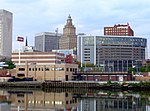Rutgers University–Newark
Rutgers University–Newark is one of three regional campuses of Rutgers University, a public land-grant research university consisting of four campuses in New Jersey. It is located in Newark. Rutgers, founded in 1766 in New Brunswick, is the eighth oldest college in the United States and a member of the Association of American Universities. In 1945, the state legislature voted to make Rutgers University, then a private liberal arts college, into the state university and the following year merged the school with the former University of Newark (1936–1946), which became the Rutgers–Newark campus. Rutgers also incorporated the College of South Jersey and South Jersey Law School, in Camden, as a constituent campus of the university and renamed it Rutgers–Camden in 1950. Rutgers–Newark offers undergraduate (bachelors) and graduate (masters, doctoral) programs to more than 12,000 students. It is classified among "R2: Doctoral Universities – High research activity". It also offers cross-registration with the New Jersey Institute of Technology (NJIT) which borders its campus. The campus is located on 38 acres in Newark's University Heights section. The university host seven degree-granting undergraduate, graduate, and professional schools, including the School of Public Affairs and Administration, Rutgers Business School (which has another campus in New Brunswick) and Rutgers Law School (which has another campus in Camden), and several research institutes, including the Institute of Jazz Studies. According to U.S. News & World Report, Rutgers–Newark is the most diverse national university in the United States.
Excerpt from the Wikipedia article Rutgers University–Newark (License: CC BY-SA 3.0, Authors).Rutgers University–Newark
University Avenue, Newark
Geographical coordinates (GPS) Address Website External links Nearby Places Show on map
Geographical coordinates (GPS)
| Latitude | Longitude |
|---|---|
| N 40.741 ° | E -74.174 ° |
Address
Rutgers University Newark
University Avenue 195
07102 Newark
New Jersey, United States
Open on Google Maps









